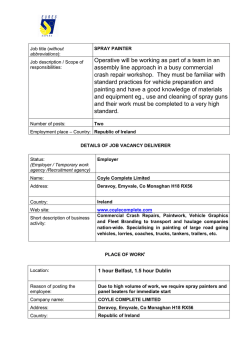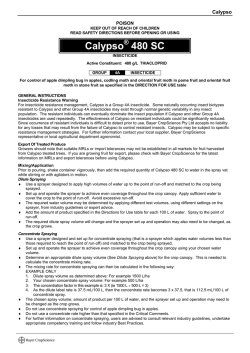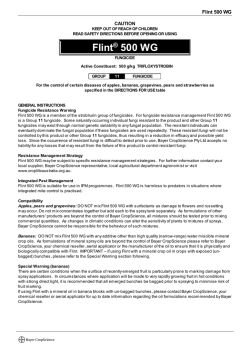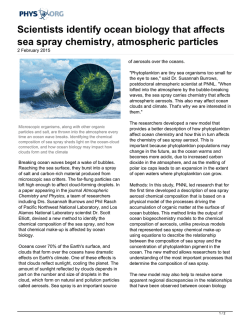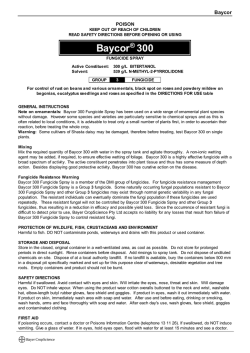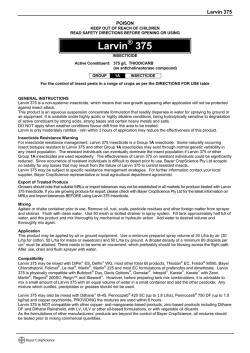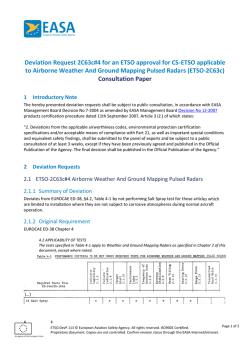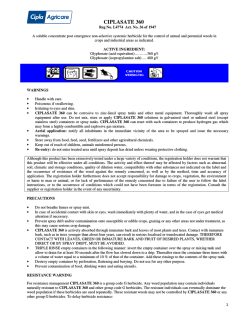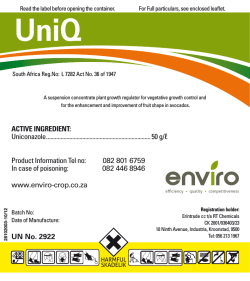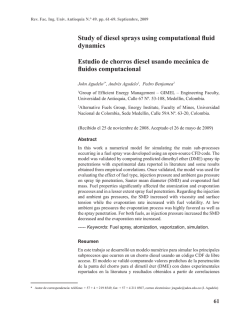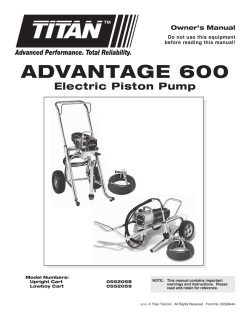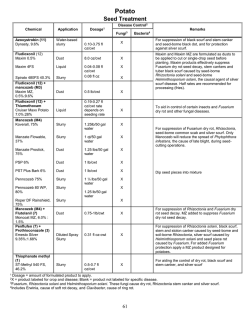
Aliette WG Systemic Fungicide
Aliette READ SAFETY DIRECTIONS BEFORE OPENING OR USING Aliette® WG SYSTEMIC FUNGICIDE Active Constituent: 800 g/kg FOSETYL-ALUMINIUM GROUP 33 FUNGICIDE For the prevention and control of phytophthora rots in apples, avocados, ornamentals, peaches and pineapples as specified in the DIRECTIONS FOR USE Table GENERAL INSTRUCTIONS Fungicide Resistance Warning For fungicide resistance management Aliette WG is a Group 33 fungicide. Some naturally occurring individual fungi resistant to Aliette WG and other Group 33 fungicides may exist through normal genetic variability in any fungal population. The resistant individuals can eventually dominate the fungal population if these fungicides are used repeatedly. These resistant fungi will not be controlled by Aliette WG and other Group 33 fungicides, thus resulting in a reduction in efficacy and possible yield loss. Since the occurrence of resistant fungi is difficult to detect prior to use, Bayer CropScience Pty Ltd accepts no liability for any losses that may result from the failure of Aliette WG to control resistant fungi. Export of Treated Produce Growers should note that suitable MRLs or import tolerances may not be established in all markets for produce treated with Aliette WG Systemic Fungicide. If you are growing produce for export, please check with Bayer CropScience Pty Ltd for the latest information on MRLs and import tolerances BEFORE using Aliette WG Systemic Fungicide. Mixing Fill the spray tank to at least half the desired amount with clean water and commence agitation. Add the required quantity of Aliette WG directly to the water and complete filling to the final volume. Continue agitation. DO NOT make a slurry or paste prior to adding to the tank. Application Good disease control requires even, thorough coverage of the target area. Application should be made using appropriate spray equipment and sufficient water to provide adequate penetration and coverage. Equipment settings and water volume may need to vary, depending on the growth stage of the crop. Special Instructions for Tree Crops Dilute Spraying ♦ Use a sprayer designed to apply high spray volumes, up to the point of run-off and matched to the crop being sprayed. ♦ Set up and operate the sprayer to achieve even coverage throughout the crop canopy. Apply sufficient spray volume to cover the crop to the point of run-off. Avoid excessive run-off. ♦ The required spray volume to achieve point of run-off may be determined by applying different test volumes, using different settings on the sprayer, or from industry guidelines or other expert advice. ♦ Add the amount of product specified in the Directions for Use table for each 100 L of water. Spray to the point of run-off. ♦ The required dilute spray volume to achieve point of run-off will change and the sprayer set up and operation may also need to be changed, as the crop grows. Concentrate Spraying (Apples and Peaches (foliar sprays) only) ♦ Use a sprayer designed and set up for concentrate spraying (that is a sprayer which applies spray volumes less than those required to reach the point of run-off) and matched to the crop being sprayed. ♦ Set up and operate the sprayer to achieve even coverage throughout the crop canopy using your chosen spray volume. ♦ Determine an appropriate dilute spray volume (See Dilute Spraying above) for the crop canopy. This is needed to calculate the concentrate mixing rate. ♦ The mixing rate for concentrate spraying can then be calculated in the following way: EXAMPLE ONLY 1. Dilute spray volume as determined above: For example 1500 L/ha 2. Your chosen concentrate spray volume: For example 500 L/ha 3. The concentration factor in this example is: 3 X (i.e. 1500 L ÷ 500 L = 3) 4. As the dilute label rate is 250 g/100 L, then the concentrate rate becomes 3 x 250, that is 750 g of product per 100 L water for concentrate spraying. Aliette ♦ ♦ ♦ The chosen spray volume, amount of product per 100 L of water, and the sprayer set up and operation may need to be changed as the crop grows. Do not use a concentrate rate greater than that specified in the Critical Comments. For further information on concentrate spraying, users are advised to consult relevant industry guidelines, undertake appropriate competency training and follow industry Best Practices. Crop Safety Ornamentals Aliette WG has been used on a wide range of ornamental plant species without damage. However, some species and varieties are particularly sensitive to chemical products. It is advisable to treat only a small number of plants first, in order to determine their reaction to the product, before large scale use. Tree Crops Under some conditions, mixtures of Aliette with foliar fertilisers may cause fruit russeting. Contact Bayer CropScience for further information on mixing with foliar fertilisers. Compatibility This product may be combined in the spray tank with: Bugmaster® Flo, chlorpyrifos, diazinon 800, Thiodan® EC, Kelthane® EC, Marlin®, maldison 500 and methamidophos. Note Mixing Aliette WG with Dithane® DF, Dithane M45, Rovral® Aquaflo or Rovral Liquid may result in some settling out. With any mixture, constantly agitate prior to and during application. It is not recommended to mix this product with more than one of the above pesticides in the tank. Always test mixtures on a small number of plants before large scale use. As formulations of other manufacturer's products are beyond the control of Bayer CropScience Pty Ltd, all mixtures should be tested prior to mixing commercial quantities. PROTECTION OF WILDLIFE, FISH, CRUSTACEANS AND ENVIRONMENT Dangerous to fish. DO NOT contaminate streams, rivers or waterways with the chemical or used containers. STORAGE AND DISPOSAL Keep out of reach of children. Store in the closed, original container in a dry, cool, well-ventilated area, out of direct sunlight. Shake empty bag into spray tank. DO NOT dispose of undiluted chemicals on site. Puncture, or shred and bury empty containers in a local authority landfill. If no landfill is available, bury the empty containers below 500 mm in a disposal pit specifically marked and set up for this purpose clear of waterways, desirable vegetation and tree roots. Empty containers and product should not be burnt. SAFETY DIRECTIONS May irritate the eyes. Avoid contact with eyes and skin. Avoid inhaling dust or spray mist. Wash hands after use. FIRST AID If poisoning occurs contact a doctor or Poisons Information Centre (telephone 13 11 26). MATERIAL SAFETY DATA SHEET Additional information is listed in the Material Safety Data Sheet, which can be obtained from www.bayercropscience.com.au. EXCLUSION OF LIABILITY This product must be used strictly as directed, and in accordance with all instructions appearing on the label and in other reference material. So far as it is lawfully able to do so, Bayer CropScience Pty Ltd accepts no liability or responsibility for loss or damage arising from failure to follow such directions and instructions. Aliette®, Bugmaster®, Rovral® and Thiodan® are Registered Trademarks of Bayer. APVMA Approval No.: 46798/55358 FOR 24 HOUR SPECIALIST ADVICE IN EMERGENCY ONLY PHONE 1800 033 111 Aliette DIRECTIONS FOR USE Restraints DO NOT use as an alternative to steam sterilisation of potting soils used in nurseries. SITUATION Apples, Peaches DISEASE Collar Rot (Phytophthora cactorum) STATE NSW, Vic, Tas, SA, WA only METHOD OF RATE APPLICATION Foliar Spray Dilute spraying: 250 g/100 L water Concentrate spraying: Refer to the Application section in GENERAL INSTRUCTIONS Soil Drench 90 g/100 L water WHP 14 days (Apples) Not required (Peaches) CRITICAL COMMENTS Apply two foliar sprays per season. Apply the first spray in early spring when trees are in full leaf. Apply the second spray 12 weeks later when the spring growth flush has matured. Apply by dilute or concentrate spraying equipment. Apply the same total amount of product to the target crop whether applying this product by dilute or concentrate spraying methods. Avocados Phytophthora Root Rot (Phytophthora cinnamomi) Qld, NSW, Vic, SA, WA only Foliar Spray Dilute spraying: 370 g/100 L water or 55 g/15 L knap-sack sprayer 1 day Pineapples Heart Rot (Phytophthora cinnamomi) Root Rot (Phytophthora nicotinanae var. parasitica) Qld, NSW, WA only Soil Drench & Foliar Spray 4.6 kg/ha 7 days Ornamentals (non edible) Crown and Root Rot (Phytophthora spp.) All States Soil Drench 90 g/100 L water (10 g/m2) NIL For concentrate spraying do not apply more than 750 g/100 L (i.e. at a concentration factor greater than 3 X) This treatment should be used for very diseased trees. Such trees have inadequate leaf area for a foliar spray to be effective. Apply approximately 10 L water per tree. For protection of trees not showing above ground symptoms of root rot. Apply 1015 L per mature tree during the spring flush and again at intervals of 6 weeks until autumn. Apply lower volume to younger trees. Add a non-ionic wetting agent according to its label directions. Excessive use of wetting agent may result in some leaf burn. Note: Concentrate spraying is not appropriate for this use. Apply as a soil drench along the plant row immediately after planting and then as a foliar spray at 6 week intervals from late summer to early winter. First Treatment: Hand drenching is recommended. Subsequent Treatments: Use 2000 L/ha for young plants increasing to 5000 L/ha for large plants. Apply at intervals of 6 weeks. Container Grown Plants: Drench volume depends on size. For 150 mm container apply 200 mL. NOT TO BE USED FOR ANY PURPOSE OR IN ANY MANNER CONTRARY TO THIS LABEL UNLESS AUTHORISED UNDER APPROPRIATE LEGISLATION WITHHOLDING PERIODS (WHP) Apples: DO NOT HARVEST FOR 14 DAYS AFTER APPLICATION. Avocados: DO NOT HARVEST FOR 1 DAY AFTER APPLICATION. Peaches: NOT REQUIRED WHEN USED AS DIRECTED Pineapples: DO NOT HARVEST FOR 7 DAYS AFTER APPLICATION.
© Copyright 2025
